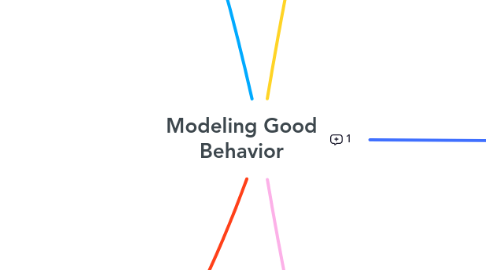Modeling Good Behavior
作者:Max South


1. ***Being Emotionally Intelligent/Relatable* **
1.1. Clytemnestra expresses her anguish from losing her daughter that she seeks justice by killing Agamemnon, who sacrificed her for the greater good. She let her rage overcome the vital diplomacy required by a leader. (*Agamemnon* 1331-1576)
1.1.1. Sometimes when leaders express emotions that are relatable they can gain more respect, support, and understanding from the public but in this particular instance she negates the reasoning for Agamemnon's decision to sacrifice their daughter for the greater good.
1.2. In Book 2 of the Odyssey, Telemachus demonstrates his willingness to take advice from others as well as vulnerability – characteristics that model good behavior. The suitors doubted his ability to fulfill his journey but instead of getting mad, he simply refuses to discuss it any further (The Odyssey 2.218-212).
1.3. In Book 9 of the Odyssey, Odysseus decides to boast to the cyclops that it was him who blinded him. This does not model good behavior as he is being arrogant and too prideful. (The Odyssey 9. 502-506).
1.4. In Book 2 of the Iliad, Odysseus models good behavior when he utilizes emotional intelligence to appeal to different members of the army based on what he thinks would inspire them when they all want to abandon the battle. He tells the high-ranking people that they would lose their honor if they leave, threatens the regular-ranking soldiers with a beating, and beats Thersites (Iliad 2.243-332).
2. ***Helping Others* **
2.1. In a flashback in Book 2 of the Aeneid, Venus models good behavior by protecting Helen from Aeneas and also telling him to flee before he gets killed (Aeneid Book 2 710-768).
2.2. In Book 1 the Aeneid, Zeus models good behavior because after listening to Venus’ pleas to spare the city of Troy, he sends a god down to ensure that the Carthagians are hospitable to the Trojans (Aeneid Book 1 350-360).
2.3. After Aegeus, King of Athens, finds out Medea has been banished, he agrees to give her shelter and protection in Athens. (Medea, 727-728)
2.4. In Book 10 of the Odyssey, Odysseus puts the needs of his men before himself when he sacrifices his own time and energy to kill a deer for his men to eat. (Odyssey 10.174-180).
2.5. In Book 12 of the Odyssey, Odysseus does not put the needs of his men above his own, as he lets Syclla eat six of his men, without them knowing, so he can return home safely. This is an example of not modeling good behavior (The Odyssey 12.223-225).
2.6. In Book 2 of the Odyssey, Athena disguises herself as Nestor and expresses words of support for the inexperienced son of Odysseus. She pushes Telemachus to stand up to the suitors and find more information about his father for the sake of his family – which demonstrates modeling good behavior (The Odyssey 2.270-296).
3. ***Making Sacrifices for the Greater Good * **
3.1. Aeneas sacrifices his relationship with Dido to begin his journey to start the Roman Empire (Aeneid Book 4 330-452).
3.2. Aeneas models bad behavior in Book 4 of the Aeneid because he abandons Dido after having sex with her, leaving her humiliated and shamed (Aeneid Book 413-420).
3.3. Jason, husband of Medea, explains that a reason he marries the princess and leaves Medea is in order to give his sons wealth and status. He therefore agrees to keep his sons in Corinth while Medea is exiled in order to provide a good life for them. (Medea, 913-915)
3.4. After Jason leaves Medea for King Creon’s daughter, Medea makes a plan to enact revenge on him. The last part of her plan is killing her sons. (Medea, 1236-1237)
3.5. In Book 1 of the Iliad, both Achilles and Agamemnon fail to model good behavior by prioritizing their pride over the good of the rest of the army. Achilles knows he is the best soldier in the army and Agamemnon knows he needs Achilles in the battle to win, but neither of them is willing to put their differences aside to support the rest of the army (Iliad 1.318-356).
4. ***Treat Others with Respect* **
4.1. In Book 24 of the Iliad, Apollo models good behavior when he advocates for both gods and humans alike to respect Hector’s corpse and the family of Hector as Achilles was abusing Hector’s dead body (Iliad 24.31-54).
4.2. In Book 24 of the Iliad, Achilles fails to model good behavior as he continuously disrespects the dead body of Hector. His anger regarding the death of his best friend Patroclus, who Hector killed, clouded his vision, and his leadership failed at this moment as a result (Iliad 24.1-15).
4.3. In the *Iliad*, Hector is respectful of his people and the gods. He even exclaims that the Trojans must pray to Zeus for he has the power to help them succeed (*Iliad* 12.278-281)
4.3.1. "No, no put our trust in the will of mighty Zeus, King of the deathless gods and men who die. Bird signs! Fight for your country - that is the best, the only omen!" Book 12, lines 278-281
5. ***Mediating/Keeping the Peace* **
5.1. Oedipus asks for help from the when investigating the murder of Laius in order to end the plaque in Thebes. Everyone convenes outside the palace to help and Oedipus turns to Creon to see if he would confront the oracle of Delphi for information to help the city (*Oedipus Rex* 1311–1684)
5.1.1. Collaborative/Understanding Personal Limitations - Leadership is not about being a godlike figure but rather exhibiting unifying qualities in order to enact significant change which is rarely achieved by a singular individual.
